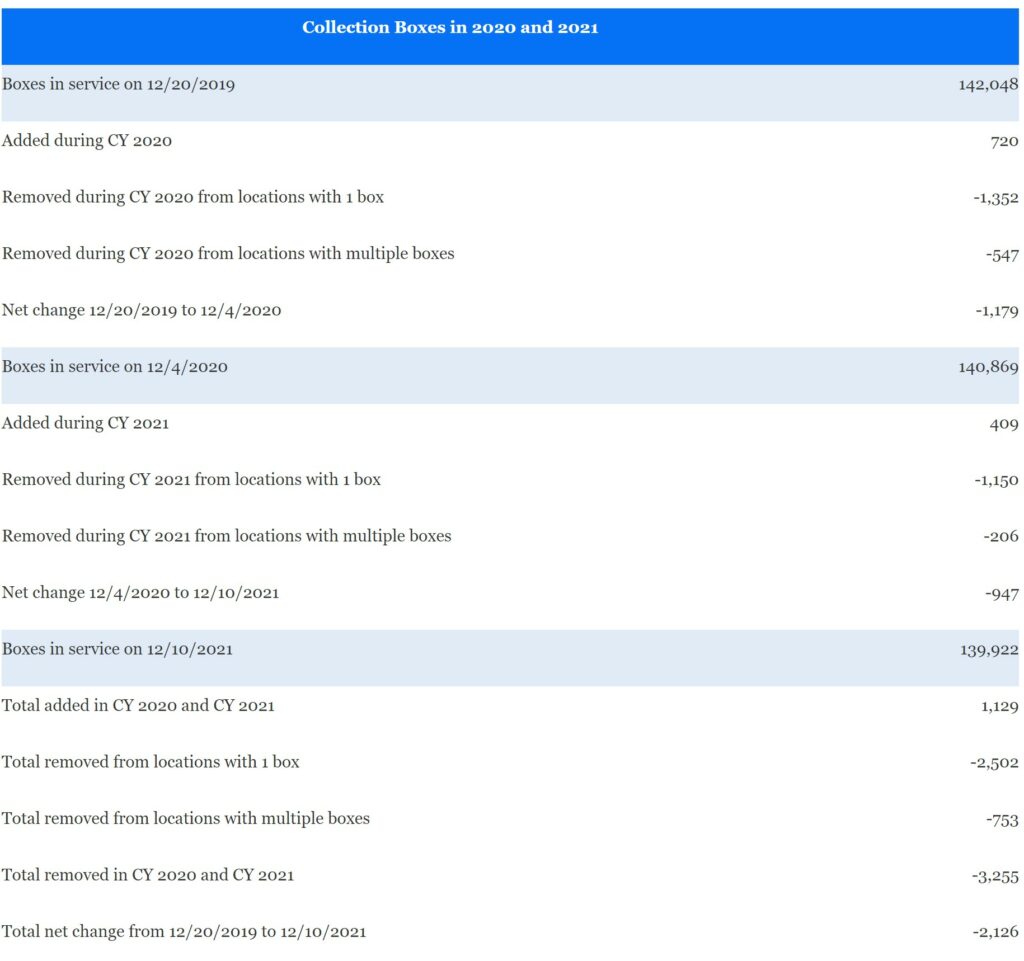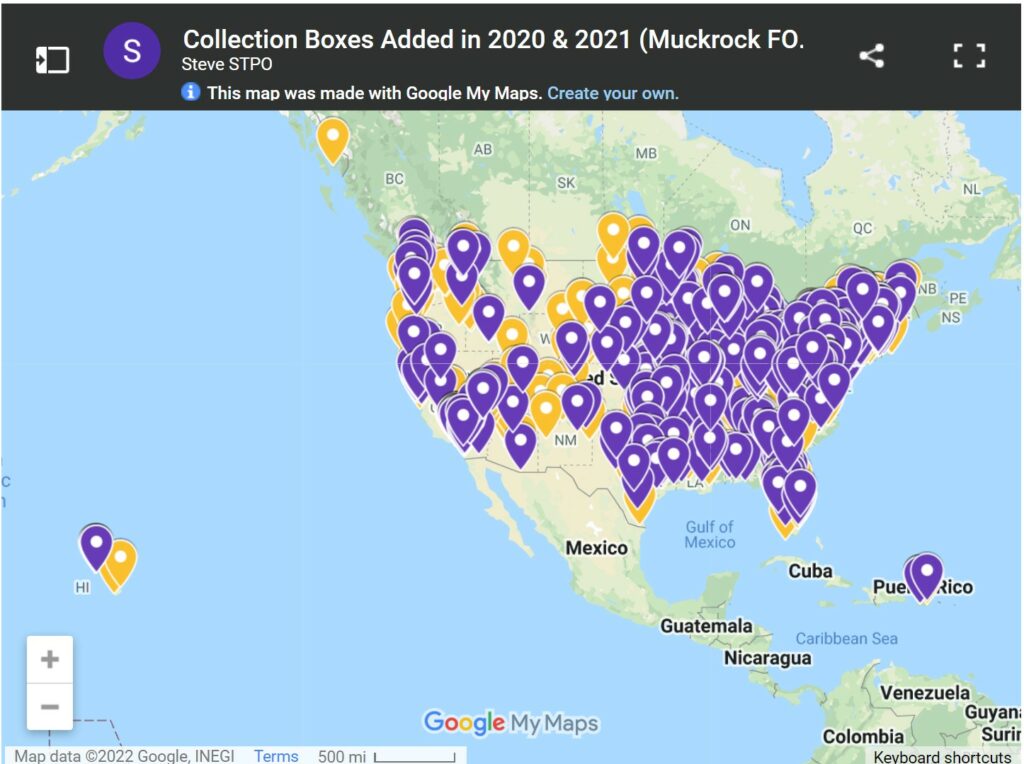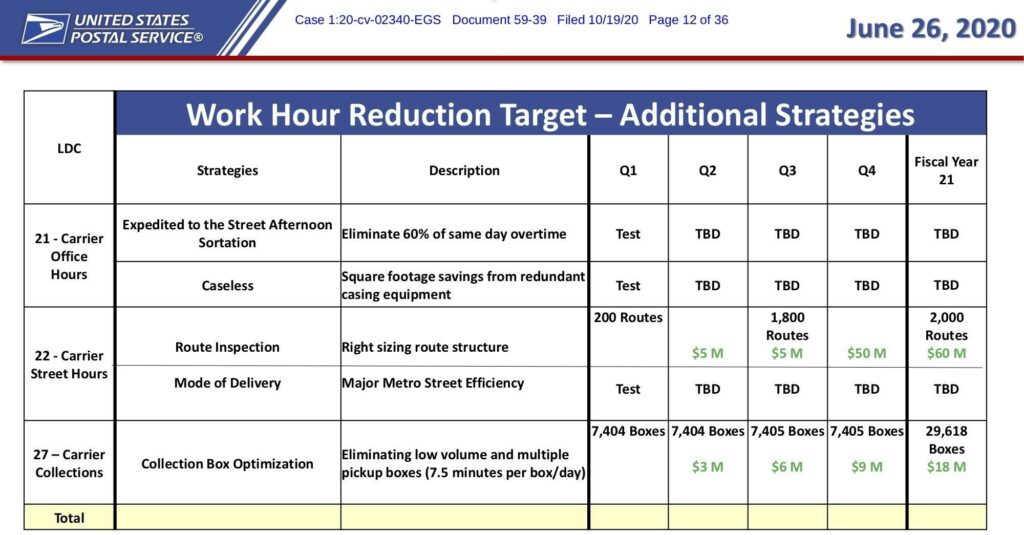US Mail Collection Box Removals
Catching up with Steve Hutkins at Save the Post Office. The removal of US Blue Mail Collection boxes is controversial especially during an election year. It forces people to find other place to mail letters, bills, ballots, etc.
Back in 2020, there was quite a bit of conversation going on about such happening and a slowing down of postal service once things were mailed. I do know it takes a day or so longer for First Class mail to get to the west coast now.
Not sure what we will see this year. As you know some states have made it more difficult to do mail-in ballots. Read directions carefully as your ballot may require IDs on the flaps also.
“Counting Up Collection Box Removals in 2020-2021: Lists & Maps,” Save The Post Office, Steve Hutkins
In the run-up to the election in November 2020, the iconic USPS blue boxes suddenly became controversial. It appeared the Postal Service was removing a lot of collection boxes just when they would be needed most – to handle all the ballots being sent by mail due to the pandemic. Images of trucks carting away blue boxes went viral. People feared the removals were part of a plan to sabotage the election.
The Postal Service said the removals were just business as usual – the routine culling of underperforming boxes. As the Postal Operations Manual explains, collection boxes are regularly examined for volume, usually once a year over a two-week period. To justify its location, a collection box must average 25 pieces a day. Boxes failing the test may be relocated to a potentially higher volume location or taken out of service. (There’s more background on box removals here.)
On August 18, 2020, under pressure from Congress and several lawsuits, the Postal Service announced it would not remove any more boxes until after the election.
A few days later, Postmaster General DeJoy testified at hearings in the House and Senate. On August 21, he told the Senate that removing collection boxes was “routine” and a “normal process that has been around for 50 years.” Due to all the “excitement,” however, he promised to postpone further removals.
During these hearings, the Postmaster General did not reveal that just a few weeks earlier, in late June and early July, he and his leadership team had held meetings about a plan to save billions of dollars by cutting 64 million workhours through a variety of initiatives, such as eliminating overtime and reducing hours at post offices. Details about this “Do It Now” plan, including slide presentations given at the meetings, were made public as evidence submitted in lawsuits against the Postal Service, including Pennsylvania v DeJoy and New York v Trump. (Three of the presentations can be found at the end of this post.)
A presentation at a meeting at postal headquarters on June 26, 2020, shows that the workhour reduction plan called for removing 30,000 “low volume and multiple pickup boxes” – 7,405 per fiscal quarter. The Postal Service projected that this “Collection Box Optimization” plan would allow it to cut carrier time by 7.5 minutes per day per box for a total savings of $18 million in FY 2021. (The slide doesn’t show the projected savings for FY 2022, after all 30,000 boxes were removed, but the annual savings would be $48 million, about $1,600 per box.)
According to an OIG report about the workhour reduction plan, “From FY 2015 through August 31, 2020, the Postal Service removed 15,779 collection boxes” – an average of about 2,630 removals a year. At that rate, removing 30,000 boxes – over 20 percent of the country’s 140,000 boxes – would take nearly twelve years. Had the optimization plan been implemented, this would have happened in just twelve months.
It’s possible that the removals that caused so much alarm in August 2020 were anything but “routine” and in fact represented the beginning of the large-scale “optimization” plan.
The FOIA request
On August 20, 2020, amidst the furor over box removals, Robert Bracco, an individual using the muckrock.com FOIA request website, filed a request asking the Postal Service to provide data “pertaining to the existence, addition, removal, or relocation of USPS collection boxes inside the United States and territories created or altered after 8/15/2019.”
On March 25, 2022 – nineteen months after the request was filed, and after seventeen follow-up messages inquiring on the status of the request – the Postal Service finally responded. It provided three lists of collection box locations in service in December 2019, 2020, and 2021. The lists make it possible to track additions and removals over this two-year period.
The totals derived from the FOIA lists are similar to those reported by the Postal Service to the Postal Regulatory Commission as part of its annual compliance review, which also came out last week. The numbers from the two sources differ slightly because the Postal Service uses the fiscal year calendar, which begins October 1, while the FOIA lists are essentially for the calendar years.
According to the PRC report, there were 1,455 boxes fewer boxes at the end of FY 2020 and 783 fewer at the end of FY 2021. According to the FOIA lists, there were 1,179 fewer boxes at the end CY 2020 and 947 fewer at the end of CY 2021. Either way, the reports show that during 2020 and 2021 the Postal Service ended up removing far fewer boxes than it had culled in previous years.
The Postal Service hasn’t commented on the existence of the plan to remove 30,000 boxes. As postal officials told the OIG, “the collection box removals made in 2020 were part of a long-standing process and handled no differently than in previous years.”
The Postal Service also hasn’t explained why it slowed the pace of removals in 2021. Perhaps postal leaders decided that generating more controversy over collection boxes just wasn’t worth the cost-savings, especially at a time when postal reform legislation was in the works and the Postmaster General continued to be under fire, for one reason or another.
What the lists show
The lists provided to Muckrock show all the collection boxes in service at three points in time: December 20, 2019; December 4, 2020, and December 10, 2021.
In many instances the lists show duplicate addresses. That’s because at many locations, like outside a busy post office, there may be two, three, even four boxes. Out of the 140,000 or so boxes nationwide, about 14,000 are at these multiple-box locations. (I haven’t done a count, but it looks like about 9.000 locations have two boxes and 2,000 have three or four.) Most of the removals occurred at locations where there was only the one box, but some took place where there were multiple boxes, leaving at least one box at that location.
The FOIA lists also show that that the Postal Service added hundreds of locations each year (relocating boxes that were underperforming elsewhere), so it’s important to distinguish between removals and net decreases.
It may be worth noting in this regard that the Postal Service is supposed to report to the PRC not only the number of boxes in service at the beginning and end of the fiscal year but also the number of boxes added and removed (39 C.F.R. § 3055.91(c)). The Postal Service has been reporting only the start and end numbers for each year, not the added and removed numbers, but for some reason the Commission has not asked for these other numbers, nor has it asked for the kind of detailed lists that Mr. Bracco requested. (See ACD Report, p. 212-214.)
In any case, the FOIA lists enable one to determine not only the total numbers for boxes added and removed but also the exact locations where the changes took place.
Counts, Lists & Maps
Here’s a chart summarizing the numbers derived from the FOIA lists.

Over this two-year period, the net decrease in boxes was about 2,120, but in fact more than 3,250 were removed — 2,500 of them at locations where no box remained.
Spreadsheet showing the three FOIA lists, along with the lists of additions and removals derived from those lists, is here. You can download the original FOIA lists here. A list of the 2,500 locations where the box was removed leaving no box in place is here (you can sort and filter by state, zip, etc.).
Angry Bear: The next two charts are static Charts. I do not have the ability to do the active charts. However, you can find the same charts at Save The Post Office in Steve Hutkin’s post “Counting Up USPO Collection Box Removal.”
Here’s a map showing the locations where 2,500 boxes were removed with no box remaining, with the markers in blue indicating those removed during 2020 and green for those removed in 2021. (If you click on a marker and then click on the “right-turn” sign next to the address, it will go to a map of the location; if you zoom in, go to street views and look around, you’ll find the box before it was removed.)

Here’s a map showing the locations where 1,129 boxes were added, with the markers in yellow indicating those added during 2020 and purple for those added in 2021.

By the way, if you’re looking for a collection box near you, the USPS Locator website will direct you to boxes in service, along with their collection times, for any zip code or address. Just limit your “collection type” to “Collection Boxes.”
(Photo: USPS collection boxes, apparently removed from the streets of New York, CNN)


“The Postal Service hasn’t commented on the existence of the plan to remove 30,000 boxes.”
As presented in the slide embedded above, there isn’t such a plan. There’s a plan to remove 7.5 minutes per collection at boxes through a combination of reducing boxes and reducing collections at boxes, i.e. instead of the box being collected at 11am and 5pm, it is now collected at just 5pm (presumably enabled because the box isn’t used enough to require a second pickup). That’s consistent with my observation of the labeling on the new format boxes in my city (we didn’t lose any boxes, but they are now new boxes that don’t permit insertion of packages, which haven’t been allowed in the mail except by handing over the counter for around 20 years at this point), they’re only picked up in the afternoon.
not so sure we can say that the reduction is just reducing the number of pickups.
You would be correct
The cluster mailboxes used for new residential developments for a long time have an outgoing mail slot. The capacity is far smaller than a regular post box, but should be sufficient to handle most outgoing mail from the dozen or so residences that it serves. I don’t know if that applies to the commercial versions.
Hmmm.
Go figure!
Trump’s Postmaster General is staying put
Bloomberg – March 31
Fred:
I am just up and I am just having my first cup. Didn’t we do this discussion one time before? Two , nope three words, oh, bull shit.
There is “no” commercial business which can perform in the same manner as the USPS and go anywhere to deliver mail and packages. The reasoning for this is to provide communication nation wide.
The President can not remove the Post Master and neither can Congress by law. Only the postal board can remove Louis DeJoy. During the entire time Trump was in office, Louis faced little opposition. Indeed. the Postal Board was shy three members who might have opposed DeJoy.
Did you not read any of former Postmaster Mark Jamison’s posts on Angry Bear?
The Post Office is tasked to deliver US Mail to all parts of the country regardless of where the recipient lives which is something other delivery services will not do. They use the USPS to deliver the last mile or so for fees.
The USPS is not meant to make a profit like FedX, UPS, etc. Indeed, if the Post Office raised its fees, the other delivery services would follow suit which is why they pressure USPS to do so. The USPS is not a business and is a service tasked by the Constitution to deliver the mail.
The issues with funding started in 2006 when move-the-football-Susan sponsored a bill requiring the USPS to prefund its retirement program to which no or few states do. Up to 2007 the USPS had a fully funded retirement program and suffered no losses.
Under DeJoy, the delivery efficiency of first class mail has suffered. The mandate was to deliver all first class mail in 1-2 days regardless of where the address was in the nation. It has been changed to 3 or more days. Be careful when you mail your bills or notifications.
In 2020 pre-election, DeJoy took it upon himself to start removing sorting equipment and mailboxes. His actions would have delayed mail-in-ballots from being delivered on a timely basis to be counted. Many mail-in-ballots also do not require postage. There were also efforts made to block postal workers from working OT to sort and deliver mail-in-ballots on a timely basis.
DeJoy is a trip. He may have managed logistics companies but I seriously doubt he got his skin head involved in the actual effort. He is not the type to soil his hands and Gemba or go-see.
I certainly noticed that the puff piece I linked/posted did not seem to mention the specially-made sorting machines that DeJoy had dismantled to ‘improve’ deliveries, or even the several PO board members who were replaced so that DeJoy could be removed – which has not happened. What is up with that?
Get rid of the guy. Return the USPS to its former glory!
Fred:
Thank you for responding. You did piss me off. I answered the dismissal already. Only the Postal Board can can LeJoy. There are two(?) more approvals to go before Biden “may” have a chance at having LeJoy fired.